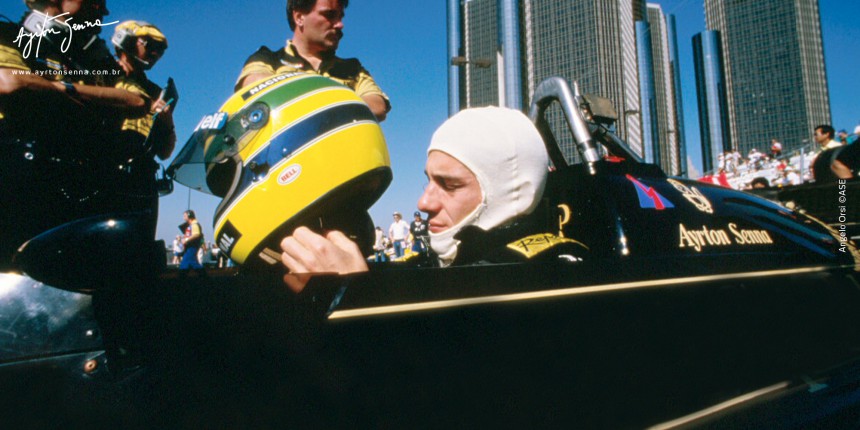As one of the highlights of his F1 debut season, in 1984, driving a Toleman, Ayrton Senna moved on to Lotus in 1985, the team with which he started fighting for victories in the main category of motor sports. Ayrton stayed on the team until the end of 1987, after scoring six wins, 22 podium finishes and 16 poles.
Senna’s first and most iconic podium finish as a Lotus driver took place when the Brazilian won for the first time in F1, at the 1985 Portuguese GP. His last one was at the 1987 Japanese GP, when Senna finished in second after starting in seventh place, at Suzuka, the same place where he would later win his three world titles with McLaren (1988, 1990 and 1991).
Take a look back at seven other historic podium finishes of Ayrton Senna with Lotus.
1985 Austrian GP
In Austria, in 1985, Ayrton Senna and team Lotus struggled during the practice sessions and started in 14th place on the grid. In the race, Senna had an excellent recovery: before the first lap was over, he was already in tenth place and, by the tenth lap, he was in sixth. Ayrton overtook several adversaries and finished the race in second place. It was Senna’s fifth podium in his career, and his second with Lotus.
1985 Belgian GP
Ayrton Senna’s second win in F1 took place at the 1985 Belgian GP. The Brazilian had momentum after three great results in a row: second place in Austria, third in the Netherlands and third in Italy. After qualifying in second place and with the track partially wet, Ayrton had a good start and was able to jump ahead of Prost. With the track starting to dry out, the Brazilian changed tires and came back behind Nigel Mansell and Elio de Angelis. Ayrton overtook his rivals and dominated the rest of the race.
1986 Brazilian GP
The Brazilian GP was the opening race for the 1986 season in Jacarepaguá, in Rio de Janeiro. On Saturday, Ayrton Senna took the pole position, with an advantage of seven tenths of a second over Piquet. The local crowd went wild with the Brazilian one-two and Senna’s first ever pole position in his home country. On the day of the race, Senna started well and kept the lead for three laps, when Piquet took over. Both Brazilian drivers secured the second Brazilian one-two in the history of the Brazilian GP. The first one had taken place in 1975, with José Carlos Pace in first and Emerson Fittipaldi in second at the Interlagos Raceway.
1986 Spanish GP
On the 1986 Spanish GP, Ayrton Senna had one of his most iconic wins in F1. On the last lap, Senna crossed the finish line just 0s014 ahead of Nigel Mansell, driving a Williams. The Brazilian driver had already scored a pole position for Lotus on the eve of the race, and led for 49 out of 72 laps at Jerez.
1986 Detroit GP
The GP was marked by an interesting story. While racing fans celebrated Senna’s win, just one day earlier, on the football fields of Mexico, where the World Cup was taking place, the Brazilian squad had been taken out of the competition by France, the country of origin for many mechanics and engineers who worked for Renault, the supplier of Lotus’ engines.
On Sunday, Senna restored the Brazilian pride by celebrating his win with a gesture that would come to symbolize his victories. The driver stopped his car during the cool-down lap, grabbed a Brazilian flag and lifted it up, taking a full lap while holding it high. From then on, that became Senna’s way of displaying the pride of representing his country in F1.
1987 Detroit GP
After his first win in Detroit, one year earlier, Senna was able to celebrate again on the streets of the USA, this time by wining with the yellow Lotus. The Brazilian started in second place and trailed Nigel Mansell for 33 laps. When the Britton stopped to change tires, Senna took the lead stayed there. In a risky bet, he spared his tires and chose not to make a pit-stop, unlike most of his adversaries.
1987 Monaco GP
The glamorous street circuit in Monte Carlo was always a special challenge for F1 drivers. In 1987, Ayrton had the second best time in the qualifying session and would be starting next to Nigel Mansell on the first row. The race on Sunday started with Mansell keeping the lead until the 29th lap, when he retired due to problems in his Williams’ Honda engine.
Senna took the lead and, from then on, ruled the race: he dominated the final 49 laps and, to boot, had the quickest lap in the race. Ayrton crossed the finish line 33 seconds ahead of Nelson Piquet, in the only Brazilian one-two ever in Monte Carlo. It was the first of Senna’s six wins at the Principality.




